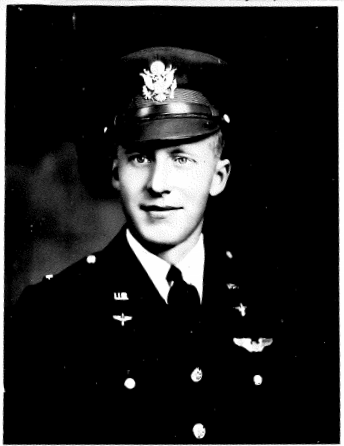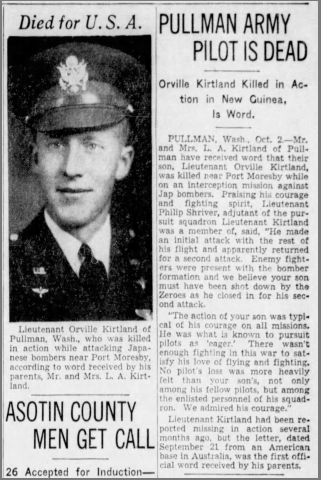Orville Austin Kirtland
Pre-WSC Background
Orville Austin Kirtland was born on June 22, 1919, in Lewiston, Idaho. Orville was the second child and first son of Lewis and Mae Belle Kirtland, who had their daughter, Ida, two years earlier. Lewis and Mae Belle originated from Ohio and Minnesota, respectively, and Lewis supported his family by working as a salesman for a local grocery store. In 1920, the Kirtland family was documented living in Lewiston, in a precinct called Orchards. The Kirtland's were a religious family, evidenced by the fact that Orville was baptized before his first birthday at Lewiston’s Congregational Church. It is unclear when the family moved but by 1931, they had moved north to Pullman, Washington.
In Pullman, the Kirtland family finally found a community in which they could settle and raise their children. During his early years, Orville was very active in school and was listed frequently in newspapers for various activities such as plays and musicals. Kirtland was also a part of the local Pullman Boy Scout troop, making it to at least the rank of second-class scout. As he grew older, Kirtland continued to stay involved when he started attending Pullman High School. While at PHS, Kirtland was a part of the student staff of the HI-Times, a bi-monthly student newspaper for Pullman High, and served for at least three semesters. Despite changes in identity that young adults go through in high school, Kirtland remained committed to the faith he had grown up with. On May 9, 1937, Kirtland was confirmed at the St. James Episcopal Church in Pullman. A few weeks later, he graduated from Pullman High School and looked to the in-town, Washington State College for his next phase in life.
Going to school at Washington State College likely seemed a logical step for Kirtland, as the school offered a quality education without requiring any sort of move to an unknown place. Pullman was his home, and the presence of a well-known institution at his doorstep made the decision to attend college easy. Nevertheless, Kirtland had other plans for his life going on before he started at WSC. In July 1937, Kirtland was noted as a guest at a Reserve Officers’ Association dinner at Fort George Wright in Spokane. He was described as an enrollee of the Citizens’ Military Training Camp who was also a candidate for a commission in the reserve corps. Kirtland was taking his first steps into a military career as he was beginning his college career, unaware of what future events held for his life.
WSC Experience
Now officially a student at WSC, Kirtland quickly got to work involving himself in extracurricular activities and clubs, establishing himself on campus and amongst his peers. By November, he was selected to the WSC frosh debate team. Despite only being a freshman, Kirtland did very well in his first year in debate, setting himself apart from his peers. By March, he was one of nine pledges for the Forensic Circle, which was described as an “underclass honorary,” which took members based on their work in debate. Even though he was involved in debate, Kirtland became a part of a fraternity during his first year. The 1938 yearbook has Kirtland pictured amongst the other members of the Sigma Alpha Epsilon fraternity, a group he was a part of throughout his time at WSC. To top off his involvements, Kirtland was also a part of the school’s ROTC program, being listed with the other noncommissioned officers that received appointments. Kirtland’s first year at WSC was eventful, showing that he was still as enthusiastic about clubs and extracurricular activities as ever. As he continued his education, Kirtland became more renowned on the WSC campus.
Kirtland’s next two years at WSC continued to be a happy time in his life. This was demonstrated in amusing fashion in articles published in the Washington State Evergreen, the student newspaper. In gossip sections of the newspaper that reported lighthearted happenings around campus, Kirtland made a couple of appearances during his sophomore year. The first article reported that the author saw a Tri-Delta sorority member and Kirtland together on the sorority porch, with Kirtland attempting to light matches by throwing from them from the porch to the street. A few months later, Kirtland was mentioned along with fellow student Don Walker as the article stated that the two “always call on Virginia Harrison together.” The article poked fun at the two men when it asked, “Is Orv giving Don his moral support or is Don cast in the supporting role to Orville?” As time passed to his junior year, Kirtland continued his involvement with the debate club. In November 1939, he was named to the varsity debate squad, showing his continued interest and skill. By the end of his junior year, Kirtland had accomplished much in only three years at WSC. Along with his involvement in debate, Kirtland was listed as a member of Sigma Alpha Epsilon for all three years in school. Though he seemed primed to complete his education, Kirtland did not return for his senior year. While he was a decent student at WSC, Orville felt a greater opportunity elsewhere as he soon enlisted into the Army Air Corps following his junior year. In March 1941, Kirtland was the driver during a head-on collision with another car while driving with three sorority sisters. All survived and most escaped with only minor injuries. Despite his brush with death, Kirtland remained undaunted and committed to his plans. On March 14, a little more than a week after the accident, Kirtland enlisted into the US Army as a flying cadet.
Wartime Service and Death
With little going on in Pullman, Kirtland looked to a career option that he had during college. Shortly after he enlisted, Kirtland was sent to Oxnard, California for his initial training at the California Aeronautical Training Corporation. Though the United States was still neutral during the first two years of World War II, American leadership prepared for possible conflict in the future. Utilizing the advances in airpower was crucial, as well as training men before the outbreak of war. During his training in Oxnard, Kirtland showed enough promise as a cadet and was later sent to an advanced Army flying school at Luke Field, Arizona. By October 31, Kirtland graduated along with 123 other cadets, along with six former WSC students. Now a full-fledged pilot, Kirtland was prepared for any conflict that might arise at any time. After December 7, his skills in the air were to be put to the ultimate test.
The attack on Pearl Harbor was one in a series of attacks by Imperial Japan across the Pacific. While some islands were taken to form a buffer against the US, many targets held resources that were desperately needed by the Japanese war machine or were potential staging grounds for future offensives. The city of Port Moresby, located on what is now Papua New Guinea, was an important location that was close to the northern tip of Australia. With Japan menacing Australia, the US and its allies attempted to halt any Japanese incursions on Port Moresby. Countering Japan in the air was critical for attaining the lofty goal of stopping the Japanese war machine. The United States quickly mustered up available pilots as Orville was soon attached to the 40th Air Squadron of the 35th Fighter Wing. The 35th Fighter Wing and its three Fighter Squadrons, the 39th, the 40th, and the 41st, were slated to defend the assailed Port Moresby. The 35th began its overseas trek on January 12, 1942, and arrived in Australia in May. For aircraft, the squadrons received the P-400 fighter, a slow plane that possessed a deadly armament but was not nearly as nimble and maneuverable as the famed Japanese Zero fighter. The battle was set between these young, untested American pilots to stave off experienced Japanese pilots that possessed one of the most advanced fighters of the war.
Now deployed overseas and waiting to engage the enemy, Kirtland, now a 2nd Lieutenant, was likely ready for action. The journey across the Pacific was long, but he still managed to keep in touch with family to the best of his ability. Mother’s Day in 1942 fell on his mother’s birthday, so Kirtland sent a cablegram from Australia saying, “Mother’s Day and birthday greetings. Love and okeh.” The word “okeh” is not a misspelling by Kirtland, rather it is an old spelling for the word “okay.” The word also appears in a previous cablegram sent by Kirtland as he reassured his family that he was “Still Quite Okeh.” Orville soon had little time to write to family as the situation continued to deteriorate in the Pacific. Fierce air raids on Port Moresby happened with regularity as Japanese bombers and their Zero fighter escorts harassed the city. It is not known how many counterattacks Kirtland was involved in, but there were consistent opportunities to battle in the skies.
Kirtland was renowned for his eagerness to fight, as a comrade once said of him that, “There wasn’t enough fighting in this war to satisfy his love of flying and fighting”. On July 11, Kirtland and his squadron intercepted a few Japanese bombers that were heading for Port Moresby. Kirtland made his initial attack and attempted a second attack on the bombers before he was intercepted by Zeroes and disappeared from his men. Kirtland was initially listed as Missing in Action as no plane or body was recovered in any searches. By October, Kirtland’s parents were given the news that their son was officially listed as Killed in Action after months of searching. Kirtland was passionate about flying and was beloved by his comrades. A letter from one that was sent to his parents stated, “[Orville] often said to me that when he left this life he wanted to leave it in the sky-fighting,” and that, “No pilot’s loss was more heavily felt than your son’s…We admired his courage and loved his happy outlook on life. We are proud to have had him as one of our number.” Orville Kirtland was 23 years old at the time of his death. Decades after the war, Kirtland’s body has still never been found but he was memorialized on tablets of the missing at the Manila American Cemetery in the Philippines. Years later, Kirtland’s name was also included in the WSU Veterans Memorial in Pullman.
Postwar Legacy
Though Kirtland reveled in combat and flying, his death is still one that is bittersweet and tragic. He served willingly and loved flying, dying in the way he desired the most. His life was brief, but he left behind a community in Pullman where he was respected and a family that cared for him deeply. Though he did not graduate from WSC, Orville was a talented student and well regarded by his peers during his time in school. Nevertheless, his commitment to his nation was strong enough for him to leave friends and a promising future behind in order to serve in the armed forces. During his service to his country, he was respected by his brothers in arms and fought tenaciously in combat until his death. His life, service to his country, and death stand out among the many stories of the soldiers that fell during World War II.






